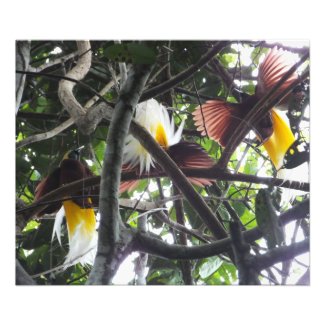I often receive request from tourists who are interested in birding in Manokwari. There are several places in the regency that are good for birdwatching and wildlife watching. I highly recommend 2 places, the Lowland Forest of Manokwari and the Lower Montane Forest of Arfak mountains.
Birding in Lowland Forest of Manokwari
 |
| Yellow-capped Pygmy Parrot (Micropsitta keiensis) |
There is a forest area in north-west region of Manokwari. Its name is Mesirrokow. It is a good site for visitors who want to watch such birds as Sulphur Crested Cockatoo, (Cacatua galerita), Moluccan King Parrot, Eclectus Parrot (
Eclectus roratus), Palm Cockatoo (
Probosciger aterrimus), Pequet (Vulturine) Parrot (
Psittrichas fulgidus), Yellow Faced Myna, Rainbow Bee-eater, Dollarbird, Little-ringed Plover, Willie Wagtail, Large tail Nightjar, Brahminy Kite, Variable Goshawk, and a lot more.
The river is also the natural habitat of a lot of species of butterflies, beetles, lizards, cuscus possum, deer, wildpigs and wallaby. The Mesirrokow forest is devided by a large river that flows to north coast of Manokwari. Various kinds of flowers can be seen growing on both sides of the river.
Since the birding site is located in the middle of the jungle, there is no guesthouse or homestay that are available at the moment. Visitors who go there will have to stay in tents. As a tourist guide, I can provide tents for visitors who want to take birding tour in this lowland forest of Manokwari.
Arfak Mountains
 |
| Lesser Birds of Paradise |
The slopes and ravines of Arfak mountains have been famous as birding and wildlife watching destination since long time ago. As a tour guide, I often organize hiking and birding tours to Mount Mabowi in Arfak mountains for people who are interested in watching cuscus possum, Lesser Birds of Paradise, Magnificent Riflebird, Magnificent Bird of Paradise, Common Paradise Kingfisher, Hooded Butcherbird, Sulphur Crested Cockatoo, Dwarf Cassowary, Papuan Frogmouth, and etc.
In addition to watching birds, visitors who go hiking in Mount Mabowi will be able to watch cuscus possum, soa-soa dragon lizard, birdwing butterflies, and fireflies. The rich ecosystem of tropical rainforest in the region is a nice site for those who want to experience hiking, camping, and wildlife watching in Arfak mountains.
 |
| Lowland Forest of Manokwari |
What you need to bring
There are no guesthousee in the forest that I mention above. Tourists who want to take the tour will stay in tents that have been prepared by I and the local villagers for tourists. However, there are things which visitors need to bring:
- Water shoes and flip-flop
- Flashlight/ torch
- Binoculars
- Insect repellent lotion
- Sun-block lotion
- Field guide book "Birds of New Guinea" written by Thane K. Pratt, Bruce Beehler and etc.
 |
| Common Paradise Kingfisher |
How to go there?
- You could fly from your country to Denpasar city in Bali island.
- I could meet you in Bali to do some birding in the forest of the island before continuing our flight to
- Take a domestic flight to Manokwari city for birding and wildlife watching trip in lowland forest and Arfak mountains.
For further info, please, contact me (Charles Roring) by email to: peace4wp@gmail.com or by whatsapp to: +6281332245180



























